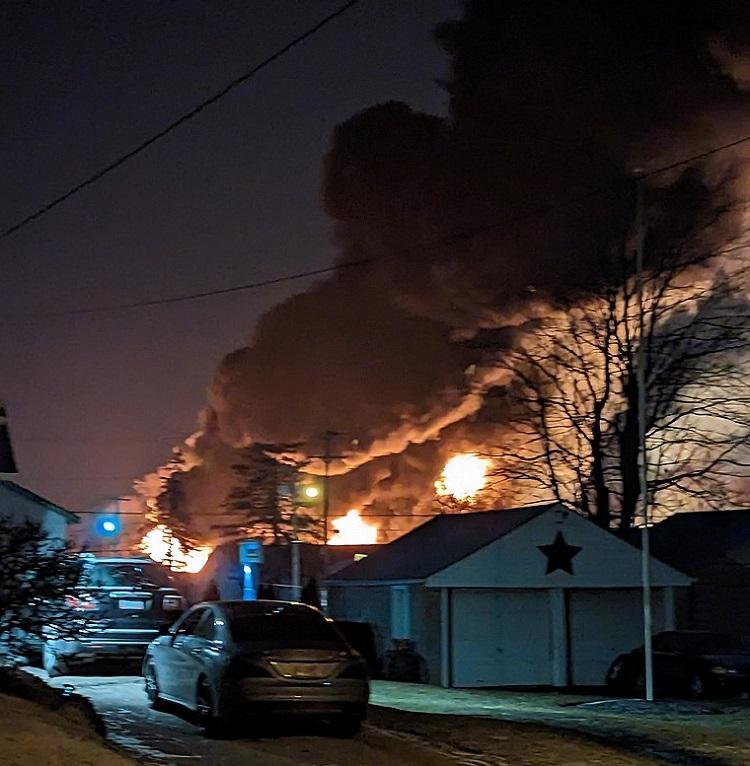This update concerns the EPA’s air data for BTEX, a group of volatile chemicals associated with petroleum products and petrochemical industry.
According to the recent data, BTEX levels in East Palestine, Ohio, concentrations of nine out of approximately 50 chemicals that the EPA has been monitoring are higher than the “normal” levels. These chemicals include acrolein, a toxic chemical that can cause inflammation and irritation of the skin, respiratory tract, and mucous membranes.
Although acrolein levels are not elevated to the point of an immediate health concern, long-term exposure can be harmful. Additionally, there are concerns about other chemicals that the EPA is not monitoring, as well as the levels of pollutants in areas where the agency does not have monitoring stations.
To address these concerns, scientists from Carnegie Mellon University and Texas A&M used a mobile air quality laboratory to evaluate air concentrations of approximately 80 chemicals along almost all the streets in East Palestine. The analysis is ongoing, and we need time to interpret the data accurately.
The EPA and local government officials have repeatedly stated that the air quality in the area is safe and that the chemicals should dissipate. However, residents have reported rashes and trouble breathing, even in their own homes. Therefore, communication about the real level of risk has been a significant source of frustration in East Palestine.
The scientists from Texas A&M and Carnegie Mellon University urge the EPA and local officials to do a better job of communicating with the public about the risks associated with the exposure to the chemicals released in the crash. It is not a black-and-white issue, and all sides are right to a certain extent. People need to understand what “safe” means in this context.
The EPA is setting up a community center where residents and business owners can ask questions about agency activity and will continue to monitor the air quality in the area and in residents’ homes. They are also collecting outdoor air samples for contaminants of concern, including vinyl chloride, n-butyl acrylate, and ethylhexyl acrylate.
Meanwhile, scientists from Texas A&M and Carnegie Mellon are monitoring the chemicals in the area using a mobile lab that they’ve used for the past decade to measure air pollution in real-time in cities across the country. They expect to release data from their own tests in East Palestine soon.
The mobile lab has extremely sensitive equipment that can measure pollution in parts per trillion. The scientists can plot the data on a graph to show, in real-time, where the concentrations of chemicals may be and at what level. The goal is to determine whether there are chemicals in the air that the EPA isn’t monitoring and to look at pollution levels in places where the agency did not set up monitoring stations.
The scientists say the situation in East Palestine needs to be monitored, and the EPA should continue measurements, and that they should also communicate with the public about what they’re seeing and put this into context of risk. Rather than use numbers, they should explain what the risks are and what precautions the residents can take to protect themselves.
About the analysis: The partnership between Carnegie Mellon University and Texas A&M Superfund for air quality in East Palestine, Ohio, is an ongoing effort to evaluate the air concentrations of approximately 80 chemicals. While BTEX levels appear “normal,” the concentrations of nine of the approximately 50 chemicals that the EPA has been monitoring are higher than the “normal” levels, and long-term exposure to acrolein can be harmful. The researchers say the EPA and local officials need to do a better job of communicating the risks to the public and continuing to monitor the air quality in the area. It is important to provide accurate information and context about the potential risks associated with the chemical exposure, especially for the residents who are in constant contact with the chemicals. Additionally, the partnership aims to address the questions of whether there are more chemicals in the air that EPA is not monitoring and what about locations where EPA doesn’t have a monitor. The researchers say the first results of this ongoing effort will be available soon, and it is important to stay tuned to better understand the risks associated with the Ohio train derailment site.
Ohio Department of Natural Resources Reports on the Train Derailment’s Impact to Wildlife
The Ohio Department of Natural Resources (ODNR) updated the number of aquatic species killed in waterways impacted by the East Palestine train derailment. A total of 2,938 aquatic species were killed, with nearly 2,200 of them being small minnows. ODNR estimates that around 38,222 minnows and 5,500 other aquatic species were potentially killed as a result of the derailment.
The investigation has concluded that the entirety of the impact to aquatic life occurred within the first 24 hours after the derailment. Live fish have since returned to Leslie Run and no additional signs of aquatic life suffering have been observed. ODNR believes that none of the species killed in this event are threatened or endangered.
ODNR is awaiting test results of several non-aquatic animals, including three birds and an opossum, to determine if they were made sick by the train derailment.
References:










